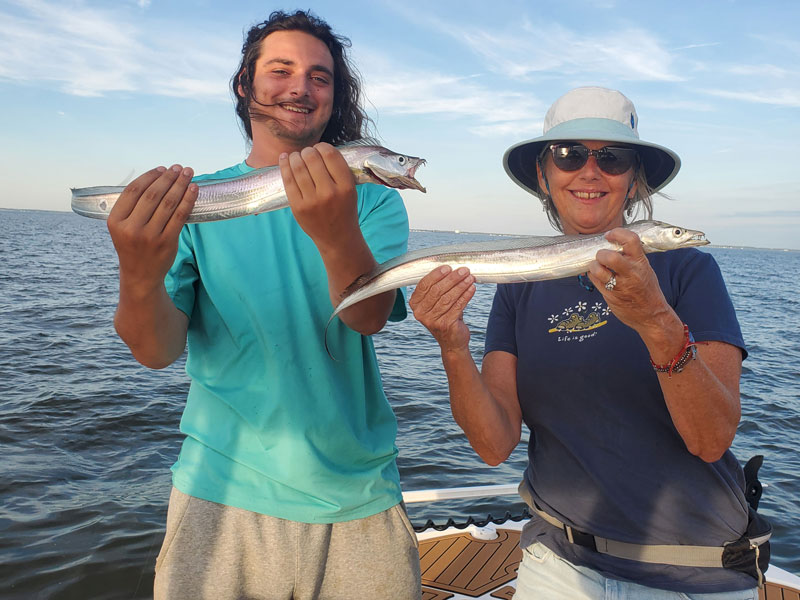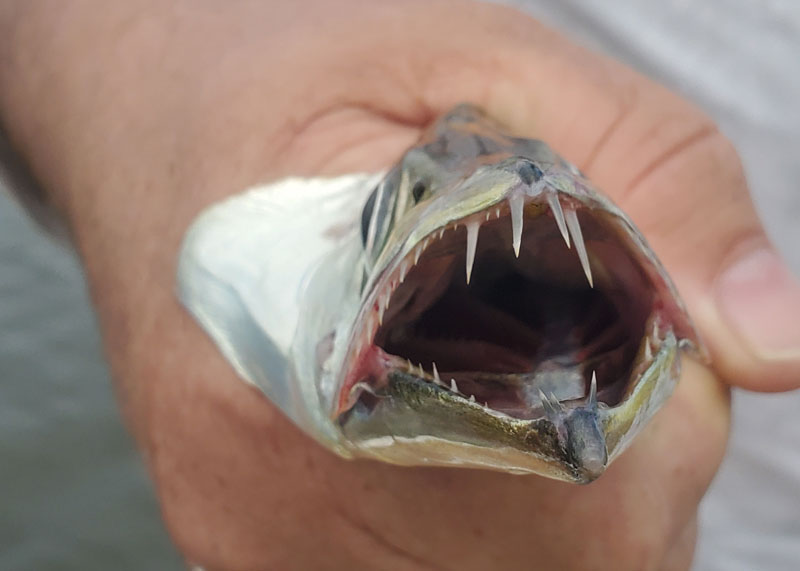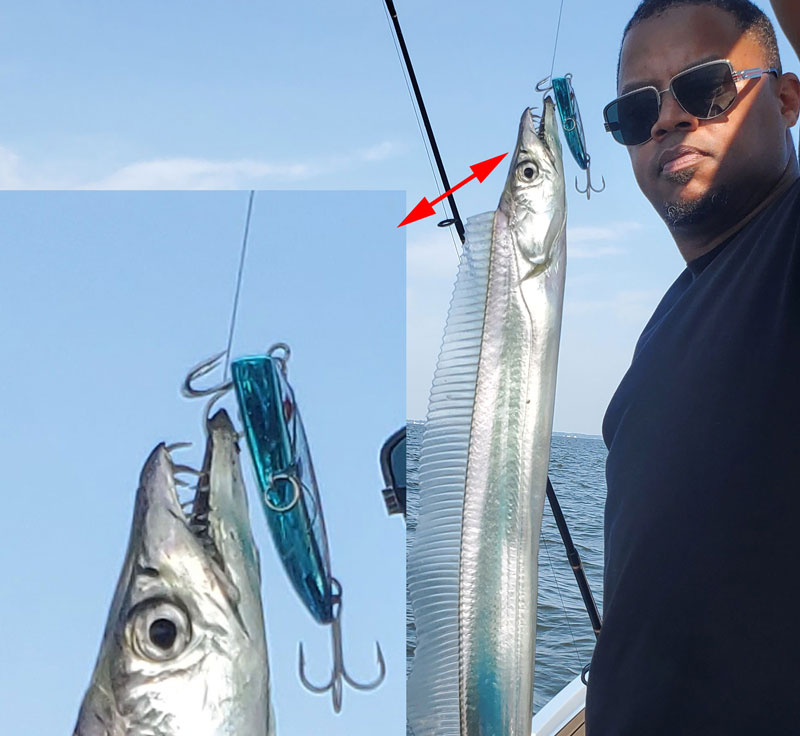Cutlassfish, AKA ribbonfish, AKA hair-tail, seem to be on a serious tear. Once they were an occasional oceanic catch, then they invaded portions of the southern Chesapeake in big numbers, and last season they expanded their rule clear up into the Middle Bay — we even had one reader check in with a cutlassfish catch from all the way up in Curtis Creek. And during the month of August a school so massive it was possible to catch dozens per hour (we counted 62 in three hours of fishing one afternoon) parked itself off the mouths of the South and West rivers. We'll dig into the details in a moment, but first check out this video we shot on how to troll for 'em.
Okay, so there can be a lot of them around and they bite like nuts. Why should we care? Because although they may look downright zany, these fish offer a unique fight and great eating. Cutlassfish can swim backwards, so they can tug quite a bit on the end of the line. Then when they stop tugging they have almost zero resistance as they’re pulled through the water, so often you think they’ve pulled free. But keep reeling and no, wait! There they are again, tugging and yanking.
Drop a few into the cooler, take them home, and you can slice away a long, thin fillet from either side of the fish. Try eating them, and you’ll quickly understand why this species is considered a delicacy in many parts of the world and can cost four to five times as much as the average fish in some Asian fish markets. The meat is firm, white, flaky, and somewhat similar to flounder in nature.

Reeling In Ribbonfish
Ribbonfish do play the tide, and at times will turn up their strangely shaped noses no matter what you may present them with. Like most fish, however, they tend to bite well when the current’s running, late in the tidal cycle, early in the morning, and late in the afternoon. In the Bay and its tribs they tend to hover around low in the water column in 10 to 25 feet of water but at times will come up to the surface and chase bait — it’s not uncommon to see their long, silvery bodies launch out of the water and grayhound much like a Spanish mackerel or a houndfish.
You can catch a cutlass casting and retrieving just about any lure in the two- to five-inch range (larger ones may be in order for bigger specimens found in the ocean), though they need to be of the bite-proof variety or you’ll reel in one tail-less bait after the next. These fish have some serious teeth and have zero problem biting through standard-issue soft plastics. In fact, when you bring one into the boat be sure to take care to keep your fingers and toes away from those snapping jaws.

When you spot cutlassfish on the surface or on your meter, or locate a school via trolling and then stop, casting to them is tremendous fun. Most of the time, however, the killer tactic to use for catching cutlassfish is light tackle trolling.
Trolling for the Cutlassfish
Towing your offerings on light tackle behind a boat at just two or three mph is deadly on these fish. Stock rockfish jigging rods and reels works great, and any light to medium action 6’0” to 7’0” rod rigged with 15-pound braid or thereabouts, plus a few feet of 20-pound fluoro leader, will get the job done. Simply pick your course, make a long cast off to either side and close the bail, and set a third line down the middle.
You can troll bite-proof plastics on leadheads or pull small spoons, but lipless diving plugs like the original Rat-L-Trap in the one-half to three-quarter-ounce size, in chrome blue and similar finishes, will utterly decimate these fish. These lures can be trolled directly from the rod tip with no additional weight or hardware, and the steady thrumming of your rod tip lets you know that it’s swimming properly; if that thrumming ever stops be sure to reel up and check for snagged weeds or a fouled line. A spread with a swimming plug on either side and a spoon set a bit farther back down the center will minimize tangles.

These fish do change color preferences from time to time but the blue/chrome Rat-L-Trap and the Strike King Red Eyed Shad Tungston 2 Tap in the Natural Shad shade proved to be epic producers last season. As for spoons, again natural colors work well but at times gold seems to generate bites when other colors don’t.
Another highly effective way to troll for cutlassfish is to set a stock-and-trade Spanish mackerel spread with #1 and #2 planers, using the exact same small spoons that entice those mackerel. The downside is that you’ll be cranking back the fish with significantly heavier gear, and because cutlassfish strike and miss quite often, you’ll need to keep an eye out for tripped planers.
Bank Fishing for Ribbonfish
Though these are mostly open-water fish, boatless anglers who want to get in on this action aren’t entirely out of luck. The king of all land-based hotspots for ribbonfish is undoubtedly casting from the shore near the Lesner Bridge in Lynnhaven. Casting Sea Striker Gotcha plugs is a local favorite tactic. In Maryland waters we’ve heard of them being caught while casting from piers at Solomons, and from shore in the Tangier Sound. We also had word of one caught from the Matapeake pier last year by an angler casting a bottom rig baited with a small chunk of spot.
Bonus Cutlassfish Fishing Tip
In the Bay and lower portions of the tribs, when you’re hunting for cutlassfish keep an eye out for osprey. They love eating cutlassfish, too, and often you’ll spot them flying back to land clutching the long, silvery fish. Look in the direction they came from, and if you spot three to five other osprey circling way above the water in the area, you know exactly where to head.
Recipes for Ribbonfish
Are you rapturous over ribbonfish? Craving the cutlass? Hoping to tear into the hairtails? We thought so. When you catch some remember that the skin of a cutlassfish is delicate, free of scales, and virtually imperceptible when eaten. So, there’s no need to worry about skinning these fillets — just slice the meat from the bones and you’re ready to start prepping a meal like one of these:
Cutlassfish Pinwheels

- Cutlassfish fillets
- Crab imperial
- Imperial topping
- Old Bay
Lay out the cutlassfish fillets skin-side-down. Slather a thin layer of crab imperial along the entire fillet. Then roll the fillet into a pinwheel. Place the pinwheel onto a cooking sheet and bake at 350-degrees for 15 minutes; top with Imperial topping and continue baking until it begins to brown on top (about five minutes). Remove from the oven, sprinkle with Old Bay, and enjoy.
Grilled Cutlassfish
- Sushi rice
- Cutlassfish fillets
- Sea salt
- Soy sauce
- Wasabi
Put the sushi rice in the cooker, and slice fillets into two-to three-inch sushi-sized pieces. Run a fillet knife across the skin side of the fillets to create a series of cuts no deeper than the skin itself. Then place the fillets on a small-mesh grilling grate or in a grilling basket, give them a sprinkle of sea salt, and grill over high flame for one minute on each side. Form the rice into balls and top each with the grilled fish; season with soy sauce and wasabi to taste.
These fish may be relative newcomers to much of the Bay’s waters, it’s true that they’re just about the zaniest-looking fish that’s started swimming our way in recent years, and we can’t guarantee that they’ll return to our waters in as vast numbers as they have in recent years. But if the reports say that cutlassfish are around, this is a target worth aiming for. The first time you reel one up it’ll trigger some giggling, and the first time you swallow one down it’ll trigger some grinning — and we guarantee you’ll be glad that these strange visitors came to town.